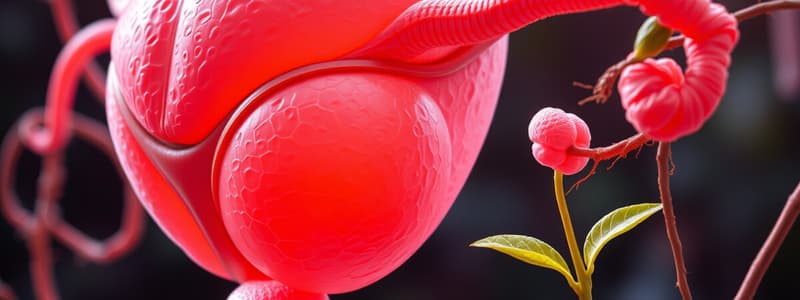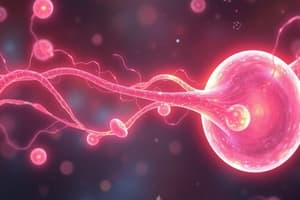Podcast
Questions and Answers
What does the concept of emergent properties refer to?
What does the concept of emergent properties refer to?
- Properties that arise in compound structures and differ from individual components. (correct)
- The ability of elements to form covalent bonds.
- The tendency of atoms to lose or gain electrons.
- Properties that are similar to individual components.
Which of the following isotopes is commonly used for carbon dating?
Which of the following isotopes is commonly used for carbon dating?
- Strontium-90
- Uranium-235
- Oxygen-16
- Carbon-14 (correct)
What is the periodic table organized by?
What is the periodic table organized by?
- Increasing atomic mass of the elements.
- Random arrangement of elements.
- Increasing atomic number and groups with similar properties. (correct)
- Decreasing atomic number of the elements.
According to the octet rule, what do atoms tend to do?
According to the octet rule, what do atoms tend to do?
Which particle determines the identity of an element?
Which particle determines the identity of an element?
How is the periodic table structured in terms of electron configuration?
How is the periodic table structured in terms of electron configuration?
What is the smallest unit of life that makes up all living organisms?
What is the smallest unit of life that makes up all living organisms?
What characterizes isotopes of an element?
What characterizes isotopes of an element?
What trend is generally observed as you move down a column in the periodic table?
What trend is generally observed as you move down a column in the periodic table?
Which of the following best describes homeostasis?
Which of the following best describes homeostasis?
Which regulatory mechanism is associated with maintaining body temperature?
Which regulatory mechanism is associated with maintaining body temperature?
What is an organ system composed of?
What is an organ system composed of?
Which of the following is NOT a form of sensitivity or response to stimuli?
Which of the following is NOT a form of sensitivity or response to stimuli?
Which characteristic describes evolution in organisms?
Which characteristic describes evolution in organisms?
What is the primary purpose of energy processing in living organisms?
What is the primary purpose of energy processing in living organisms?
Which level of biological organization is a group of similar cells performing a specific function?
Which level of biological organization is a group of similar cells performing a specific function?
What is the main structural characteristic of steroids?
What is the main structural characteristic of steroids?
Which of the following is a function of cholesterol?
Which of the following is a function of cholesterol?
What role do steroid hormones such as testosterone and estrogen play?
What role do steroid hormones such as testosterone and estrogen play?
What type of bond links amino acids in proteins?
What type of bond links amino acids in proteins?
Which steroid hormone helps regulate immune response?
Which steroid hormone helps regulate immune response?
What distinguishes anabolic enzymes from catabolic enzymes?
What distinguishes anabolic enzymes from catabolic enzymes?
Which of the following is NOT a type of steroid hormone?
Which of the following is NOT a type of steroid hormone?
Which statement about proteins is correct?
Which statement about proteins is correct?
What is the primary disadvantage of staining cells for microscopy?
What is the primary disadvantage of staining cells for microscopy?
What is the maximum magnification of most light microscopes used in college biology labs?
What is the maximum magnification of most light microscopes used in college biology labs?
What type of microscope uses a single convex lens?
What type of microscope uses a single convex lens?
What part of the microscope provides stability and support?
What part of the microscope provides stability and support?
Which microscopes can achieve magnifications of up to 100,000 times?
Which microscopes can achieve magnifications of up to 100,000 times?
What is one major requirement for electron microscopes to function effectively?
What is one major requirement for electron microscopes to function effectively?
What is the function of the coarse adjustment knob on a microscope?
What is the function of the coarse adjustment knob on a microscope?
What is the primary function of the condenser lens in a microscope?
What is the primary function of the condenser lens in a microscope?
What resolution can electron microscopes achieve?
What resolution can electron microscopes achieve?
Which type of microscopic slide is best for observing motile specimens?
Which type of microscopic slide is best for observing motile specimens?
How does the iris diaphragm affect the observation of specimens?
How does the iris diaphragm affect the observation of specimens?
What is the role of staining in microscopy?
What is the role of staining in microscopy?
What is indicated by the terms 'Dry Mount,' 'Wet Mount,' and 'Smear Mount'?
What is indicated by the terms 'Dry Mount,' 'Wet Mount,' and 'Smear Mount'?
Which component is responsible for the initial magnification of a specimen?
Which component is responsible for the initial magnification of a specimen?
What does the field diaphragm do in a microscope?
What does the field diaphragm do in a microscope?
Which statement best describes how light elements are essential in microscopy?
Which statement best describes how light elements are essential in microscopy?
Flashcards are hidden until you start studying
Study Notes
Reproduction and Development
- Ensures offspring exhibit characteristics similar to parents.
- Growth and development essential for species continuity.
Regulation and Homeostasis
- Homeostasis maintains internal balance within organisms.
- Regulatory mechanisms include nutrient transport and blood flow.
- Thermoregulation is crucial for controlling body temperature.
Cellular Organization
- Cells are the smallest unit of life, categorized into prokaryotic and eukaryotic types.
- Tissues consist of similar cells performing specific functions.
- Organs are structures formed by different tissues working collaboratively.
- Organ systems consist of groups of organs performing complex functions.
Evolution
- Evolution involves gradual changes leading to the emergence of new species from older ones.
Isotopes and Periodic Table
- Isotopes: Variants of elements with the same protons but different neutrons.
- Carbon-14 dating provides methods to date materials using isotopic composition.
- The periodic table organizes elements by increasing atomic number and similar properties.
Chemical Properties
- Properties of elements largely influenced by outermost electrons.
- Atoms strive for stability through full outer shells, following the octet rule.
- Emergent properties arise in compound structures, differing from individual components.
Steroids and Proteins
- Steroids are lipids with a core structure of four fused carbon rings; they are hydrophobic.
- Cholesterol is vital for maintaining membrane fluidity and synthesizing other steroids.
- Proteins are formed from amino acids linked by peptide bonds, folding into complex shapes.
- Functions of proteins include enzymatic (catalyzing reactions), catabolic (breaking down substances), and anabolic (building compounds).
Microscopy Techniques
- Microscopes are vital for observing cells, magnifying objects and providing clarity.
- Light microscopes can magnify cells up to 400 times with resolution around 200 nanometers.
- Electron microscopes offer higher magnification (up to 100,000x) and resolution (50 picometers) but require sample preparation that kills specimens.
Microscope Components
- Two basic types: simple (single lens) and compound (multiple lenses).
- Essential parts include the base for stability, arm for carrying, stage for slides, and various lenses for magnification.
- Condenser lens enhances illumination and contrast, while iris diaphragm controls light reaching the specimen.
Slide Preparation Methods
- Different slides include flat, concave, dry mount, wet mount (for motile specimens), and smear mount (for blood).
- Staining techniques enhance visibility of cellular structures, aiding identification and observation.
Role of Extracellular Matrix
- The intracellular matrix supports internal processes while the extracellular matrix provides structure and facilitates communication between cells.
Studying That Suits You
Use AI to generate personalized quizzes and flashcards to suit your learning preferences.




